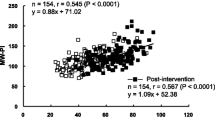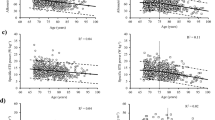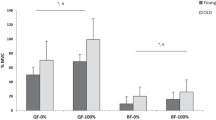Abstract
Background
Fatigability of older adults is relevant with regard to physical performance, falls and physical activity. Objective and inexpensive assessment tools for testing fatigability in the persons’ home environment are not available.
Aims
The aim of this study was to develop a protocol to objectively measure fatigability during repeated sit-to-stand performance in older persons.
Methods
Decrease of maximum velocity of performance during repeated sit-to-stand transfers and the number of repetition when achieving a 10, 15, and 20 % fatigue threshold were measured in 49 community-dwelling older women using a linear encoder.
Results
Mean maximum velocity of the sit-to-stand performance was 1.12 m/s (SD 0.17 m/s) with an estimated change of velocity per repetition of −0.0037 m/s (95 % CI −0.0039 to −0.0035) during the test. The mean number of repetitions representing 10, 15, and 20 % fatigue threshold was 8.1, 13.8, and 21, respectively.
Discussion
This simple test protocol provides objective information about the decrease of performance of a daily task in older adults.
Conclusion
Fatigability of the sit-to-stand performance can be measured objectively by measuring the decrease of maximum velocity of consecutive repetitions and the repetition number achieving a 20 % fatigue threshold.


Similar content being viewed by others
References
Evans WJ, Lambert CP (2007) Physiological basis of fatigue. Am J Phys Med Rehabil 86:S29–S46
Helbostad JL, Sturnieks DL, Menant J, Delbaere K, Lord SR, Pijnappels M (2010) Consequences of lower extremity and trunk muscle fatigue on balance and functional tasks in older people: a systematic literature review. BMC Geriatr 10:56
Tinetti ME, Speechley M, Ginter SF (1988) Risk factors for falls among elderly persons living in the community. N Engl J Med 319:1701–1707
Gill TM, Desai MM, Gahbauer EA, Holford TR, Williams CS (2001) Restricted activity among community-living older persons: incidence, precipitants, and health care utilization. Ann Intern Med 135:313–321
Davidson BS, Madigan ML, Nussbaum MA, Wojcik LA (2009) Effects of localized muscle fatigue on recovery from a postural perturbation without stepping. Gait Posture 29:552–557
Helbostad JL, Leirfall S, Moe-Nilssen R, Sletvold O (2007) Physical fatigue affects gait characteristics in older persons. J Gerontol A Biol Sci Med Sci 62:1010–1015
Glynn NW, Santanasto AJ, Simonsick EM, Boudreau RM, Beach SR, Schulz R, Newman AB (2015) The pittsburgh fatigability scale for older adults: development and validation. J Am Geriatr Soc 63:130–135
Simonsick EM, Schrack JA, Glynn NW, Ferrucci L (2014) Assessing fatigability in mobility-intact older adults. J Am Geriatr Soc 62:347–351
Kluger BM, Krupp LB, Enoka RM (2013) Fatigue and fatigability in neurologic illnesses: proposal for a unified taxonomy. Neurology 80:409–416
Cronin JB, Hing RD, McNair PJ (2004) Reliability and validity of a linear position transducer for measuring jump performance. J Strength Cond Res 18:590–593
Lindemann U, Farahmand P, Klenk J, Blatzonis K, Becker C (2015) Validity of linear encoder measurement of sit-to-stand performance power in older people. Physiotherapy 101:298–302
Gray M, Paulson S (2014) Developing a measure of muscular power during a functional task for older adults. BMC Geriatr. 14:145
Jones CJ, Rikli RE, Beam WC (1999) A 30-s chair-stand test as a measure of lower body strength in community-residing older adults. Res Q Exerc Sport 70:113–119
Zijlstra A, Mancini M, Lindemann U, Chiari L, Zijlstra W (2012) Sit-stand and stand-sit transitions in older adults and patients with Parkinson’s disease: event detection based on motion sensors versus force plates. J Neuroeng Rehabil 9:75
Van Lummel RC, Ainsworth E, Lindemann U, Zijlstra W, Chiari L, van Campen P, Hausdorff JM (2012) Automated approach for quantifying the repeated sit-to-stand using one body fixed sensor in young and older adults. Gait Posture 38:153–156
Lindemann U, van Oosten L, Evers J, Becker C, van Dieen JH, van Lummel RC (2014) Effect of bed height and use of hands on trunk angular velocity during the sit-to-stand transfer. Ergonomics 57:1536–1540
Acknowledgments
The authors thank Aileen Currie for proof-reading the manuscript and declare that they have no conflict of interest. The study was funded by the German Research Council (BE 2338/2-1). The funding bodies had no role in study design; collection, analysis, or interpretation of data; in the writing of the manuscript; or in the decision to submit the manuscript for publication.
Author information
Authors and Affiliations
Corresponding author
Ethics declarations
Conflict of interest
On behalf of all authors, the corresponding author states that there is no conflict of interest.
Informed consent
Written informed consent was obtained from all individual participant included in the study prior to data collection.
Human and animal rights
All procedures performed in this study involving human participants were in accordance with the standards of the ethic committee of the local university and with the 1964 Helsinki declaration and its later amendments or comparable ethical standards.
Rights and permissions
About this article
Cite this article
Lindemann, U., Klenk, J. & Becker, C. Assessment of fatigability of older women during sit-to-stand performance. Aging Clin Exp Res 28, 889–893 (2016). https://doi.org/10.1007/s40520-015-0495-0
Received:
Accepted:
Published:
Issue Date:
DOI: https://doi.org/10.1007/s40520-015-0495-0




